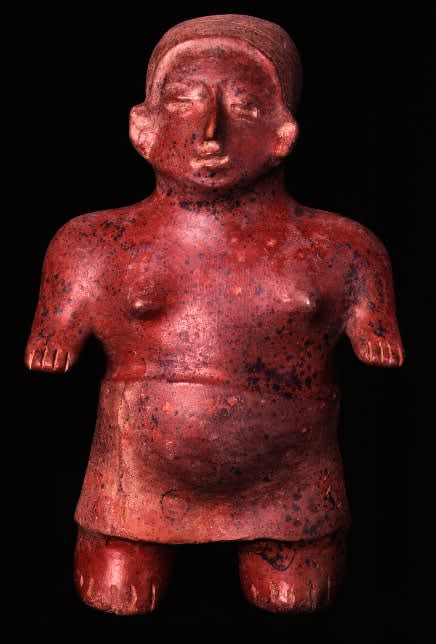Colima Sculpture of a Standing Woman, 300 BCE - 300 CE
Terracotta
11.75
PF.0874
The Colima are part of a group of archaeological cultures – known almost purely from their artworks – referred to as the Western Mexico Shaft Tomb (WMST) tradition. There are...
The Colima are part of a group of archaeological cultures – known almost purely from their artworks – referred to as the Western Mexico Shaft Tomb (WMST) tradition. There are many distinct groups within this agglomeration, and their relationships are almost totally obscure due to the lack of contextual information.
All of the cultures encompassed under the WMST nomenclature were in the habit of burying their dead in socially-stratified burial chambers at the base of deep shafts, which were in turn often topped by buildings. Originally believed to be influenced by the Tarascan people, who were contemporaries of the Aztecs, thermoluminescence has pushed back the dates of these groups over 1000 years. Although the apogee of this tradition was reached in the last centuries of the 1st millennium BC, it has its origins over 1000 years earlier at sites such as Huitzilapa and Teuchitlan, in the Jalisco region. Little is known of the cultures themselves, although preliminary data seems to suggest that they were sedentary agriculturists with social systems not dissimilar to chiefdoms. These cultures are especially interesting to students of Mesoamerican history as they seem to have been to a large extent outside the ebb and flow of more aggressive cultures – such as the Toltecs, Olmecs and Maya – in the same vicinity. Thus insulated from the perils of urbanization, they developed very much in isolation, and it behooves us to learn what we can from what they have left behind.
The arts of this region are enormously variable and hard to understand in chronological terms, mainly due to the lack of context. The most striking works are the ceramics, which were usually placed in graves, and do not seem to have performed any practical function (although highly decorated utilitarian vessels are also known). It is possible that they were designed to depict the deceased – they are often very naturalistic – although it is more probable that they constituted, when in groups, a retinue of companions, protectors and servants for the hereafter. More abstract pieces – such as reclinatorios – probably had a more esoteric meaning that is hard to recapture from the piece.
The current piece falls within the Colima style, which is perhaps the most unusual stylistic subgroup of this region. Characterized by a warm, red glaze, the figures are very measured and conservative, while at the same time displaying a great competence of line. They are famous for their sculptures of obese dogs, which seem to have been fattened for the table. Colima reclinatorios are also remarkable, curvilinear yet geometric assemblages of intersecting planes and enigmatic constructions in the semi-abstract.
As with any real woman, this West Mexican beauty has an air of mystery about her, something unspoken, perceived perhaps but not easily understood. The mystery does not lie in her appearance, which is generously feminine, but just out of reach in her gaze, which seems to look inward rather than outward. Perhaps she is contemplating the knowledge acquired by centuries in another, darker world.
All of the cultures encompassed under the WMST nomenclature were in the habit of burying their dead in socially-stratified burial chambers at the base of deep shafts, which were in turn often topped by buildings. Originally believed to be influenced by the Tarascan people, who were contemporaries of the Aztecs, thermoluminescence has pushed back the dates of these groups over 1000 years. Although the apogee of this tradition was reached in the last centuries of the 1st millennium BC, it has its origins over 1000 years earlier at sites such as Huitzilapa and Teuchitlan, in the Jalisco region. Little is known of the cultures themselves, although preliminary data seems to suggest that they were sedentary agriculturists with social systems not dissimilar to chiefdoms. These cultures are especially interesting to students of Mesoamerican history as they seem to have been to a large extent outside the ebb and flow of more aggressive cultures – such as the Toltecs, Olmecs and Maya – in the same vicinity. Thus insulated from the perils of urbanization, they developed very much in isolation, and it behooves us to learn what we can from what they have left behind.
The arts of this region are enormously variable and hard to understand in chronological terms, mainly due to the lack of context. The most striking works are the ceramics, which were usually placed in graves, and do not seem to have performed any practical function (although highly decorated utilitarian vessels are also known). It is possible that they were designed to depict the deceased – they are often very naturalistic – although it is more probable that they constituted, when in groups, a retinue of companions, protectors and servants for the hereafter. More abstract pieces – such as reclinatorios – probably had a more esoteric meaning that is hard to recapture from the piece.
The current piece falls within the Colima style, which is perhaps the most unusual stylistic subgroup of this region. Characterized by a warm, red glaze, the figures are very measured and conservative, while at the same time displaying a great competence of line. They are famous for their sculptures of obese dogs, which seem to have been fattened for the table. Colima reclinatorios are also remarkable, curvilinear yet geometric assemblages of intersecting planes and enigmatic constructions in the semi-abstract.
As with any real woman, this West Mexican beauty has an air of mystery about her, something unspoken, perceived perhaps but not easily understood. The mystery does not lie in her appearance, which is generously feminine, but just out of reach in her gaze, which seems to look inward rather than outward. Perhaps she is contemplating the knowledge acquired by centuries in another, darker world.
Literature
V2



